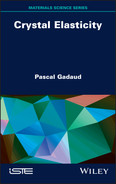Conclusion
Here is the end of this dimensionless, multiscale, experimental and vibrational description of elasticity, and particularly of crystal elasticity. Structuring all the information as clearly as possible, while maintaining a guiding line, was a complicated task. The numerous cross-references are an indication of the extent to which all the aspects related to elasticity are interlinked. It is up to the reader to go “dig” for the information of interest where it can be found.
While it may be thought that the description of elasticity is simple and that literature is a reliable source of data related to all the materials, this work attempts to show that the study of the elasticity of functional materials is actually a multifaceted universe full of surprises. In this work, many illustrations related to the follow-up of elasticity with temperature, or its relation with the structural or physical properties, were chosen for the interest they presented in the science of materials. However, enigmas, such as the atypical case of temperature of ferroelectrics or the sensitivity to confinement of semiconductors, still persist.
The dimensionless representation developed in the first part of this work makes it possible to simplify the writing of the elasticity of continuous media; it leads sometimes to unexpected relations between elastic constants and authorizes the comparison of all crystals. It also has the merit that it provides several rules for assessing the quality of the data summarized in the literature.
The “nano-Hooke” law was proposed to facilitate the transition from elasticity at the macroscopic scale to elasticity at the atomic scale. It has the advantage of being simple and not involving complex physical concepts. As for its usefulness, it remains to be appreciated.
The part dealing with the case of polycrystals is intended to be a phenomenological approach, allowing a comparison of the results of various mechanical approaches. The proposed simplified approach will most certainly save many hours of numerical calculation to those willing to adopt it.
The second part focusing on the Lagrangian approach of vibrations is entirely dedicated to its application to the characterization of elasticity, and certainly addresses far fewer readers. It nevertheless has the advantage that it proposes a unique description for various vibrating systems, making it possible to use the simplest cases as illustrations for a course of mechanics of materials. It also proposes a new alternative to the analysis of internal stresses in a simple manner, at least for bulk materials.
The dynamic resonant method, which is a very sensitive method for the characterization of the elasticity used throughout this book, has certainly reached a peak at the end of the 20th century for providing complete data, but it appears to have become obsolete. It may be that the need for characterization is not as strong as in the past, although the emergence of new (multi)materials, such as those elaborated by additive manufacturing, proves the contrary.
